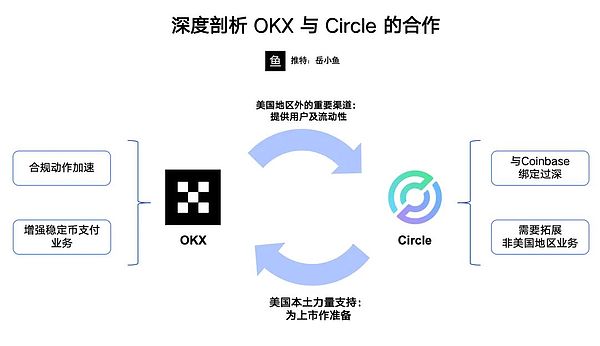Many people actually do not understand the major event of OKX and Circle establishing a cooperation, which reveals a lot of information.
First, why did OKX and Circle reach a cooperation?
To understand why this cooperation occurred, we must first understand the current situation of both parties.
1. First, let's look at OKX's current situation:
For OKX, there have been rumors of a potential US listing, and its compliance efforts have been accelerating.
Previously, it stopped DEX services for compliance rectification and is now clearing out non-compliant users and funds.
These actions indicate that OKX's compliance path is extending further, with the ultimate goal of listing on the US stock market.
At this time, OKX needs a heavyweight US domestic partner to provide stronger support for its listing journey.
On the other hand, there are also considerations in stablecoin payment business. Previously, OKX specifically developed OKX Pay, and expanding upstream to stablecoin issuers would be very valuable. By cooperating with Circle, OKX can occupy an important ecological position in stablecoin payments and gain a larger profit space in the entire payment process.
2. Now, let's look at Circle's current situation:
Circle has already gone public in the US and seems to be at the height of its success, but there is a very significant potential risk: being too closely tied to Coinbase.
This goes back to the history of USDC:
USDC was initially issued by Center, a joint venture company of Circle and Coinbase, with both companies sharing 50/50 equity and control.
In the second half of 2023, Center closed, and all control was transferred to Circle, which is now fully responsible for USDC operations.
However, according to the agreement disclosed in Circle's prospectus, Coinbase still holds 50% of USDC's profits and receives additional dividends based on its USDC holding proportion on the platform.
Last year, Circle's profit was about $1.6 billion, of which about $1 billion was paid to Coinbase.
There is also a very important agreement between these two companies: if Circle cannot pay dividends to Coinbase or encounters regulatory issues, Coinbase has the right to take over USDC as the issuer.
Therefore, although USDC is now fully operated by Circle, Coinbase still plays an important role.
This explains why Circle and Coinbase are now so closely tied.
3. Back to the stablecoin business itself
The most critical aspect of the stablecoin business is liquidity.
Many stablecoin issuers are exchanges because exchanges are natural channels.
Without circulation, a stablecoin can hardly succeed.
Initially, Circle's cooperation with Coinbase solved the biggest pain point: immediately gaining circulation, users, and trading pairs after issuance.
As the largest US exchange, Coinbase brought huge traffic and brand credibility to USDC.
Now, Circle needs to address the potential problem of being too closely tied to Coinbase.
Today, Circle has found the second exchange outside the US that can provide users and liquidity, which is OKX.
Some might ask: Why not Binance?
Mainly because Binance does not need USDC that much.
Before Circle's listing, Binance was unaware that Circle paid $1 billion in promotion fees, receiving only $60 million, while Coinbase received $900 million.
So why would Binance help promote USDC? It can be seen that Binance is now siding with the Trump family's USD1.
In comparison, OKX, the second-largest exchange outside Binance, needs Circle more.
4. To summarize
In any case, the cooperation between OKX and Circle can be said to be mutually beneficial:
OKX becomes Circle's first non-US compliant exchange partner, bringing very strong compliance and US domestic support for its listing journey, and also enhancing its stablecoin payment business.
For Circle, OKX is a good channel outside the US. Cooperating with OKX can reduce Coinbase's restrictions and expand new users and liquidity.








